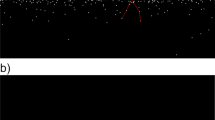Abstract
We present a scheme for obstacle detection from optical flow which is based on strategies of biological information processing. Optical flow is established by a local “voting” (non-maximum suppression) over the outputs of correlation-type motion detectors similar to those found in the fly visual system. The computational theory of obstacle detection is discussed in terms of space-variances of the motion field. An efficient mechanism for the detection of disturbances in the expected motion field is based on “inverse perspective mapping”, i.e., a coordinate transform or retinotopic mapping applied to the image. It turns out that besides obstacle detection, inverse perspective mapping has additional advantages for regularizing optical flow algorithms. Psychophysical evidence for body-scaled obstacle detection and related neurophysiological results are discussed.
Similar content being viewed by others
References
Barlow HB, Levick RW (1965) The mechanism of directional selectivity in the rabbit's retina. J Physiol (London) 173:477–504
Bohrer S, Bülthoff HH, Mallot HA (1990) Motion detection by correlation and voting. In: Eckmiller R, Hartmann G, Hauske G (eds) Parallel processing in neural systems and computers, North-Holland, Amsterdam New York, pp 471–474
Bülthoff HH, Little JJ, Poggio T (1989) A parallel algorithm for real-time computation of optical flow. Nature 337:549
Coxeter HSM (1987) Projective geometry, 2nd edn. Springer, New York Berlin Heidelberg
Duda RO, Hart PE (1973) Pattern classification and scene analysis. Wiley, New York
Epstein LI (1984) An attempt to explain the differences between the upper and lower halves of the striate cortical map in the cat's field of view. Biol Cybern 49:175–177
Gibson JJ (1950) The perception of the visual world. Houghton Mifflin, Boston
Hassenstein B, Reichardt W (1956) Reihenfolgen-Vorzeichenauswertung bei der Bewegungsperzeption des Rüsselkäfers Chlorophanus. Z Naturforsch (B) 11:513–524
Hildreth EC (1984) Computations underlying the measurement of visual motion. Artif Intell 23:309–354
Horn BKP, Schunk BG (1981) Determining optical flow. Artif Intell 17:185–203
Horn BKP, Weldon Jr EL (1988) Direct methods for recovering motion. Int J Comput Vision 2:51–76
Hughes A (1977) The topography of vision in mammals of contrasting life style: comparative optics and retinal organisation. In: Crescitelli F (eds) The visual system of vertebrates. Handbook of Sensory Physiology, VIII/5. Springer, Berlin Heidelberg New York, pp 613–756
Johnston A (1989) The geometry of the topographic map. Vision Res 29:1493–1500
Little JJ, Verri A (1989) Analysis of differential and matching methods for optical flow. In: Proc. Workshop on Visual Motion. IEEE
Little JJ, Bülthoff HH, Poggio T (1988) Parallel optical flow using local voting. In 2. Int Conf Computer Vision (ICCV). IEEE
Longuet-Higgins HC, Prazdny K (1980) The interpretation of a moving retinal image. Proc R Soc London B 208:385–397
Mallot HA, von Seelen W (1989) Why cortices? Neural networks for visual information processing. In: Ewert J-P, Arbib MA (eds) Visuomotor integration: amphibians, comparisons, models, and robots. Plenum Press, New York pp 357–382
Mallot HA, Schulze E, Storjohann K (1989) Neural network strategies for robot navigation. In: Dreyfus G, Personnaz L (eds) Neural networks from models to applications. I.D.S.E.T. Paris, pp 560–569
Mallot HA, von Seelen W, Giannakopoulos F (1990) Neural mapping and space-variant image processing. Neural Networks 3:245–263
Scott GL (1988) Local and global interpretation of moving images. Pitman, London
Seelen W von, Storjohann K, Schulze E, Mallot HA (1988) Verfahren zum Segmentieren dreidimensionaler Szenen. European Patent Application No. 88115757. 2, 1988
Verri A, Poggio T (1989) Motion field and optical flow: qualitative properties. IEEE Trans Pattern Anal Machine Intell 11:490–498
Warren WH Jr, Whang S (1987) Visual guidance of walking through apertures: body-scaled information for affordances. J Exp Psychol Human Percept Perf 13:371–383
Waxman AM, Wohn K (1988) Image flow theory: a framework for 3D inference from time-varying imagery. In: Brown C (eds) Advances in computer vision, vol 1. Erlbaum, Hillsdale, NJ pp 165–224
Zeil J, Nalbach G, Nalbach H-O (1989) Spatial vision in a flat world: optical and neural adaptation in arthropods. In Singh RN, Strausfeld NJ (eds) Neurobiology of sensory systems. Plenum Press, New York
Author information
Authors and Affiliations
Rights and permissions
About this article
Cite this article
Mallot, H.A., Bülthoff, H.H., Little, J.J. et al. Inverse perspective mapping simplifies optical flow computation and obstacle detection. Biol. Cybern. 64, 177–185 (1991). https://doi.org/10.1007/BF00201978
Received:
Accepted:
Issue Date:
DOI: https://doi.org/10.1007/BF00201978




